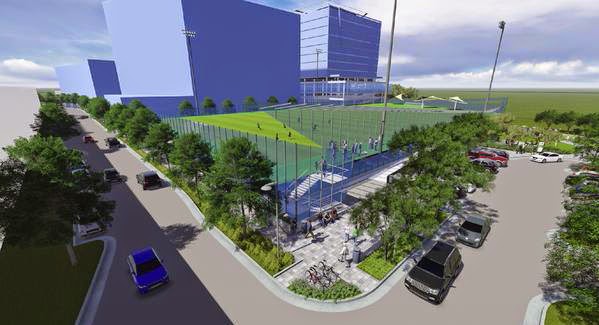Tysons redevelopment will transform the entire region
 |
| Part of the proposed Arbor Row development in the Westpark Drive area of Tysons. |
A hundred and fifty years ago, Tysons Corners was literally the intersection of two roads, with not much else. It’s now a traffic-clogged employment center poised to become a big city with a lot more residents. And its name is being shortened to “Tysons” now that it’s not a rural crossroads any more.
Planning for and managing all the redevelopment is going on under the leadership of the Fairfax County Office of Community Revitalization (OCR).
OCR Director Barbara Byron and Michael Caplin, executive director of the Tysons Partnership, presented an overview of the effort to manage the transformation of Tysons at a meeting of the Fairfax Committee of 100 Sept. 16.
The goal is to create a “livable urban center,” Byron said, with a more balanced mix of jobs and residents and multimodal transportation making it easier and more pleasant for pedestrians to get around.
When the planning started, there were just 17,000 residents. Tysons now has 19,000 residents and 100,000 jobs. The goal is 100,000 residents and 200,000 jobs by 2050. An additional 3 million square feet of development has already been added.
The planning effort started in 2005, and the Board of Supervisors approved the Tysons Corner amendment to the Fairfax County Comprehensive Plan in 2010, with the densest development planned for the areas closest to the Metro stations. The opening of Metro’s Silver line in July was a huge boost in accelerating the redevelopment.
With more people living and working in Tysons, the planners hope more people will be able to walk or take transit to their jobs, resulting in less traffic congestion and less demand for parking facilities.
Tysons is already the economic engine of Northern Virginia and 12th largest business center in the United States, Byron said. Seven buildings are under construction, and more are expected to start in the next few months.
Projects under way include the 14-story Mitre 4 facility on Colshire Drive. Fourteen projects have been approved, including a plan from the Georgelas Group for a 17-building, 24.4 acre mixed-use complex on Leesburg Pike.
Three new projects have already come online, including the Ascent apartments by the Spring Hill Metro station (rent starts at $1,845 for a studio), the Ovation at Park Crest apartments near the West Park Metro station, and the new 22-story Intelsat headquarters building by the Tysons Corner Metro station.
Fairfax County planners are hoping to create “a people-focused urban setting” that people will want to come to, Byron said, and key elements in making that happen is a new grid of streets, street-oriented retail, and new public facilities.
The plan calls for urban-design, vertical public facilities, including a school and two fire stations, plus a network of green spaces, civic parks, and athletic facilities. The area needs significantly more public and cultural facilities, Byron said, including a community center, library, police station, religious institutions, and public art.
Some of these facilities are planned by developers. Capital One, for example, is incorporating a community center, into its new complex. George Mason University plans to develop an education center on the site of Clyde’s.
To facilitate the street grid, OCR worked with the Virginia Department of Transportation to come up with new standards for urban streets with narrower lanes and other changes aimed at making the area more pedestrian oriented.
Funding for the new streets comes from a combination of sources, including contributions from developers, revenue from the Tysons tax district, and state and county funds. The BoS also endorsed a plan for a new Tysons circulator bus.
According to Caplin, the planning for a new urbanized Tyson didn’t generate a huge amount of opposition because there weren’t that many residents.
The partnership’s goal is to create a “humane and appealing place to live.” The focus is on quality of life issues, governance, and sustainability, he said.
 |
| The Meridian Group is pitching a park with athletic fields on top of a parking deck at its proposed Tysons Technology Center on Gallows Road. [Photo from Washington Business Journal.] |
To improve quality of life, the partnership is promoting “exciting design,” public art, and parks. Caplin noted some of the developers are creating temporary, “pop-up parks” and other facilities on vacant land not ready for redevelopment.
The Lerner project, for example, has set aside 10 acres of vacant land for festivals, such as the Beer, Bourbon and BBQ Festival (Sept. 20, 2-6 p.m. at the Lerner Town Square by Tysons II). Another property is being used for a Sunday farmers market.
To “build the spirit of community,” banners will be installed along Route 7, Caplin said. There are also plans to make the Metro trestles more attractive.
The partnership is promoting the use of the Silver Line as the best way to get to Nationals and Wizards games and other events in D.C. “We need massive behavior modification to reduce peak-hour traffic,” Caplin said. That includes efforts to get Tysons-based companies to give employees incentives for using transit and carpooling and allowing more flexible work hours.


Nice! Now if east and south of the county can get some love from Fairfax OCR.
Great news. Maybe we can house the low income folks that will be cleaning up, serving, maintaining, and working there. I doubt if they will have any RSU, why doesnt anyone think of the working poor.
They all live in the Penny Gross's Mason District. Why build RSU's when they can live in Mason!